Invented by Chee Leong Lum, Waheed Abid, Peter Douglas, Ivan Zivkovic, Becton Dickinson and Co
One of the key factors driving the growth of this market is the aging population. As the global population continues to age, the demand for medical devices such as pacemakers, insulin pumps, and prosthetics is expected to increase. This has created a significant opportunity for companies involved in medical device assembly.
Another factor contributing to the growth of this market is the increasing prevalence of chronic diseases. Chronic diseases such as diabetes, cardiovascular diseases, and respiratory disorders require the use of medical devices for diagnosis, treatment, and monitoring. As the number of people affected by these diseases continues to rise, the demand for medical devices and consequently medical device assembly is also expected to increase.
Advancements in technology have also played a crucial role in the growth of the medical device assembly market. The development of miniaturized and wireless medical devices has opened up new possibilities in the field of healthcare. These devices are not only more convenient for patients but also allow for remote monitoring and real-time data analysis. As a result, companies involved in medical device assembly are constantly innovating to keep up with the evolving technology landscape.
Furthermore, the increasing focus on personalized medicine has also contributed to the growth of the medical device assembly market. Personalized medicine aims to provide tailored medical treatments based on an individual’s genetic makeup, lifestyle, and other factors. This requires the development of specialized medical devices that can deliver personalized treatments. As a result, companies involved in medical device assembly are investing in research and development to create customized devices that can meet the specific needs of patients.
In terms of geographical distribution, North America currently dominates the medical device assembly market. This can be attributed to the presence of a well-established healthcare infrastructure, a large patient population, and a favorable regulatory environment. However, the market is also witnessing significant growth in Asia Pacific, driven by factors such as increasing healthcare expenditure, rising disposable incomes, and a growing awareness of healthcare.
In conclusion, the market for medical device assembly is experiencing significant growth due to factors such as the aging population, increasing prevalence of chronic diseases, advancements in technology, and the focus on personalized medicine. As the demand for medical devices continues to rise, companies involved in medical device assembly are well-positioned to capitalize on this growing market.
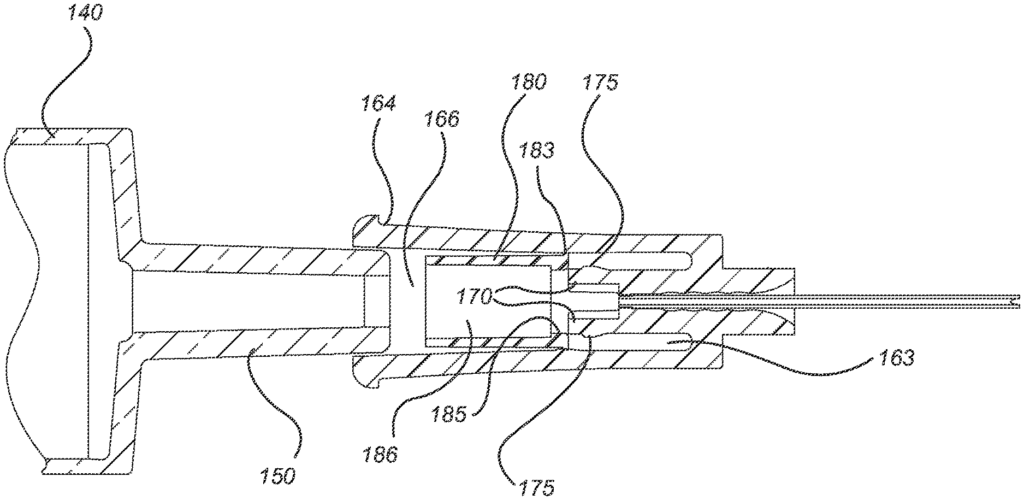
The Becton Dickinson and Co invention works as follows
The assembly of medical devices with a secure connection mechanism to connect a hub securely to fluid containers using a luer-slip relationship is described. A medical device illustrating an example includes a hub that forms a cavity and a second indicating component disposed in the cavity which engages the hub. A second indicating component contoured in a way to make a line-contact with the hub is an additional feature of the medical device. In one configuration, the hub has a first indicating component attached to it and extending into the cavity with a protrusion. The medical device can be configured in a way that includes a fluid container with an indicator system to visually indicate optimal fluid-tight engagement between the hub and fluid container.
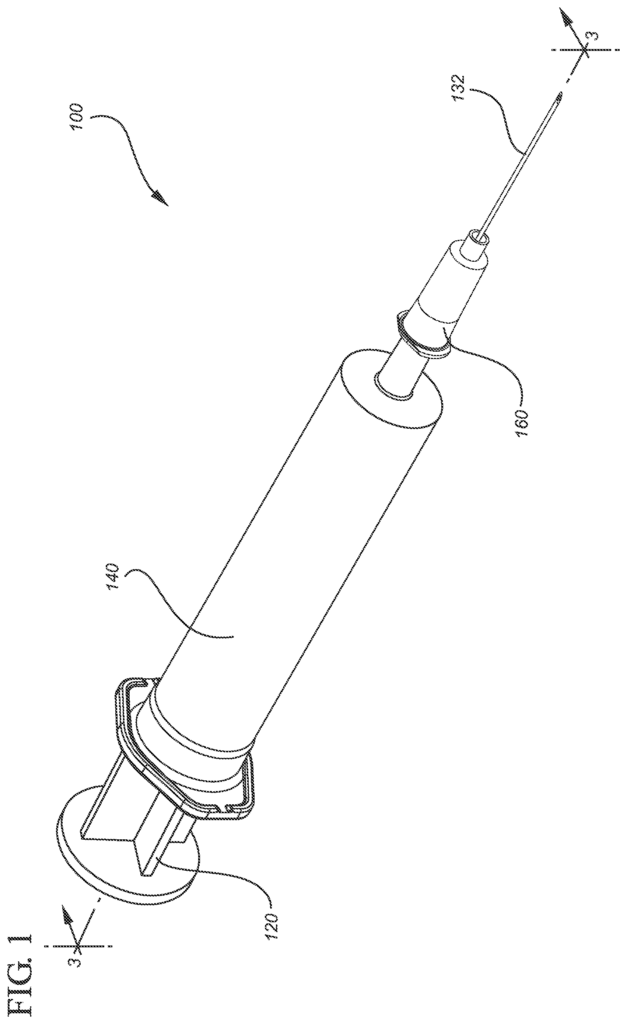
Background for Medical device assembly
Hubs and luer fittings are commonly used to assemble fluid storage containers such as syringes that have a luer connection or fitting. The ‘luer lock’ and ‘luer slip? are two common mechanisms that connect hubs to syringes. “The?luer lock? mechanisms.
The luer-lock mechanism is a fluid container that has a male fitting placed in coaxial relation to an internally threaded neck. The hub of a female luer-lock fitting or a cooperating hub has external lugs that engage the collar of the male conical fitting when a torque or twisting force is applied to the hub.
The luer-slip fitting is a fluid container that has a male fitting with no threaded collar. Female luer-slip fittings and cooperating hubs have a surface that slides over the surface of the male fitting. The hub and male fitting are attached in a friction or interference fit. The user must slide the hub over the male fitting with enough force to create a fluid-tight connection between the hub, and the male fitting. If the hub is not securely connected to the medical device, it can lead to a ‘pop off.’ “Pop offs” are when the hub is not securely connected to the male fitting.
A medical device that has a mechanism to securely connect a hub with fluid storage containers using a luer-slip relationship, as described herein, is a viable way to solve these problems. There is also a need for an indicator that shows a secure connection between the hub and fluid storage container.
A first aspect” of the invention relates to medical devices that are used with fluid storage containers. When the fluid storage container securely connects to the hub, the medical devices form line contact interactions between the first indicating elements of the hub and the second indicating elements of the hub. The term “line contact” is used in this document. Contact between two surfaces in two or more places, whether one or both surfaces are compressible or non-compressible. The term “surface contact” is used in this context. The term’surface contact’ or ‘point contact” shall include any point-to-point contact between two surfaces, where one or both of the surfaces are compressible and/or noncompressible. Contact between two surfaces in a single location, whether one or both surfaces are compressible or non-compressible. In one or several embodiments, a hub has a distal opening and an open proximal side. A sidewall extends from the distal to the proximal, forming a cavity. The medical device also includes a first indicator element attached to distal end and extending into cavity, as well as a second indicator element within the cavity. In one or several embodiments, either the first or second indicating elements are flexible.
In one or more embodiments the opening at the hub’s distal end is fluidly connected to the cavity. Optionally, the hub can include a needle-cannula that is attached to its distal tip and extends in a distal direction. The needle cannula that is used in one or more embodiments has a proximal and distal end as well as a lumen. In alternative embodiments, the hub can include a safety cover covering the needle. In one embodiment, the hub can include a coaxial sidewall extending from the distal tip of the hub. This wall forms a channel that is between the coaxial and the sidewall to receive the safety cap.
The first indicating component has a distal tip attached to the hub’s distal end and a proximal tip that extends in the hub’s cavity. In one or several embodiments, the first indicating elements distal ends surround the opening at the distal tip of the hub. In one or more embodiments, the first indicating component forms a recess along with the sidewalls of the hub. The first indicating component may also include a protrusion extending radially outward. The protrusion may be disposed on the outer surface of the first element, and extend into the recess between the first element and the sidewalls of the hub.
The second indicating element in one or more embodiments has an open proximal and distal ends, as well as a body that extends from the open proximal to distal ends. The inside surface of the body defines a hollow interior. The body of an embodiment of the second indicator element can be hollow and cylindrical.
In one or more embodiments the hollow interior has a size and shape that allows it to receive or enclose the first indicating component. In one embodiment, the hollow inner allows the body from the second indicating to enter the recess between the first indicating and the sidewalls of the hub. When a force is applied to the second element, the body enters the recess. In some embodiments, the protrusion on the first indicating component prevents the body of the second indicating member from entering the recess unless a distally directed force is applied. In one embodiment, the protrusion of the first indicating element is shaped or adapted to move proximally in the hollow interior the second element as it enters the recess.
According to one or more embodiments, the inside of the second indicator element or the width of the cross-section formed by the interior surface is contoured in a way that forms a line contact with the first element when a force is applied on the second element. The term “cross-sectional” is used in this document. The term “cross-sectional width” shall refer to the distance between the two points located on the circumference of the edge or the cross-sectional surface of an object with a circular cross-section and a non-circular one. Two points can be placed on the circumference or edge or the interior or outer surface of the cross section of an object. Cross-sectional width is a term that should be understood. The ‘cross-sectional width’ The object’s?diameter? What is meant by ‘cross-sectional size? The terms ‘cross-sectional width? “The terms ‘circle’ and?diameter?
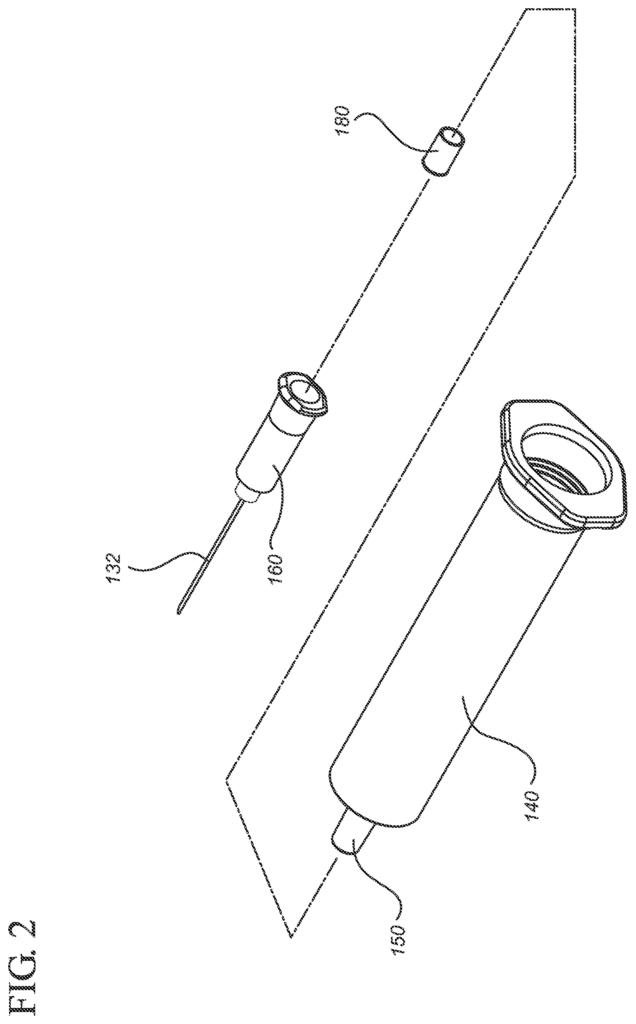
In a particular embodiment, the inner surface has a first diameter section adjacent to the distal open end of the second indicator element. Inside surface can also include a second axially extending diameter portion extending from first diameter portion towards the open proximal. In one or more embodiments the diameter of inside surface increases from the first diameter toward the open proximal portion of the second indicating elements.
According to one or more embodiments the second indicating component includes an interior surface that defines a cross-sectional size. The inside surface comprises a tapered section adjacent to the distal open end of body, a steeply ramped portion adjacent to this tapered section, and an enlarged segment adjacent to the proximal open end of body. In some embodiments, a ramped section extends axially from the tapered portion to the enlarged portion. In one embodiment, the width of the interior surface’s cross-section increases along the length of the ramped section from the tapered to the enlarged portion. As will be explained herein, the second indicating component of one or several embodiments can slide distally on top of the first indicating component. In one embodiment, the ramped surface of the interior of the second element is configured to form a line-contact interaction with the first element when the second element receives it. In a specific embodiment, the axial distance of the ramped part may be reduced in order to provide tactile feedback when a fluid storage vessel and a hub are engaged fluid-tight.
The second indicating component with tapered portions may be used with a first element that has a protrusion that is shaped or adapted to slide past the tapered section upon application of predetermined force to the second element in a distal relative direction to the first element. The protrusion can also be shaped or adapted so that the second element cannot engage the first element, nor slide distally past the first element, until a certain force is applied in the proximal direction to the second element.
The open distal end in one or more embodiments has a solid or continuous perimeter. The continuous or solid circumference in one or more embodiments has a circular shape that is maintained when a force is applied distally to the second indicating component until the hub and fluid container are engaged fluid-tight.
One or more embodiments may include means for indicating the application of a force to the hub that is sufficient to cause fluid-tight engagement between the hub and a fluid storage system. According to one or more embodiments the means forms two or more contact points with hub. The hub, for example, may have a distal end with a first indicating component extending proximally from the opening into the cavity. The means then forms two or more contact points when applying force to the hub. In some embodiments, the first indicating component may include a protrusion extending radially. The means for indicating can also comprise a hollow cylindrical member with a proximal and distal ends and an interior surface that extends from the proximal to distal ends and has a diameter increasing from the distal to the proximal. In one embodiment, the hollow cylindrical has a circular section that retains its circular shape when the force is applied to the hub. The means for indicating, in a more detailed embodiment, produces tactile feedback when the fluid-tight engagement between the hub and fluid storage device is achieved.
A second aspect” of the invention is a feature which includes a visual indication. The visual indicator can be used in conjunction with any of the embodiments described herein. The visual indicator can be disposed on the fluid storage system, such as adjacent to its opening. In some embodiments, the liquid storage device comprises a syringe with a luer-tipped barrel. The visual indicator is located on the luer-tipped barrel. In alternative embodiments the fluid storage device comprises a male connector with the visual indicator disposed on it. The visual indicator can be positioned on the tip of the fluid transfer device so that it is clearly visible before the fluid-tight engagement between the fluid-transfer and the hub or medical device. The first portion of the visual indication is visible also when the connection between fluid storage device (FSD) and medical device (MDE) is not tightened. According to one or more embodiments a second portion that is less than the initial predefined portion is visible when the fluid storage device is optimally tightened and/or the hub is fluid-tight. In one embodiment, the visual indication is not visible if the connection between fluid storage device (FSD) and hub is too tightened. Fluid storage devices can be used with any of the embodiments of medical devices, regardless of whether they have a visual indicator feature.
The following description of an exemplary embodiment of the invention should be taken as a reminder that the invention does not limit itself to the construction details or the process steps described. The invention can be embodied in other ways and practiced in different ways.
One aspect of the invention is a medical assembly that can be attached or connected in a fluid-tight engagement to a fluid storage vessel. One or more embodiments of the medical device assembly may use a first indicating component and/or second indicating component to indicate fluid-tight attachment with a container. In one or more embodiments, the medical device assembly includes a hub with means for indicating the application of force to the hub that results in fluid-tight engagement with a container. The means for indicating can be used during engagement of the fluid storage vessel and the medical device assembly in a luer-slip configuration. The embodiments of medical device assemblies described in this document may be used with optional needle cannulas and/or optional needle tip caps.
FIGS. The medical device assembly shown in FIGS. 1-21 is a medical instrument assembly that can be used according to one or several embodiments. Medical device assemblies can be used in conjunction with liquid storage containers, such as syringes barrels, needleless intravenous sets or other devices for storing and/or transferring medication or other fluids. The fluid storage container may include an opening that allows access to its contents in one or more embodiments. The opening can include a male luer fit or be configured in another way for use with a medical device assembly.
FIGS. The invention includes a medical assembly comprising a hub 160 with means for indicating the application of force to the hub that is sufficient to cause fluid-tight engagement between a fluid container 140 and the hub. FIGS. 1-21 show the assembly. In some embodiments, means for indicating the application of a force form at least two points of contact with the hub when the force is applied. In some embodiments, a means of indicating the application of a force comprises a first indicating component 170 integrally formed or attached to the hub or a second indicating component 180 located within the hub.
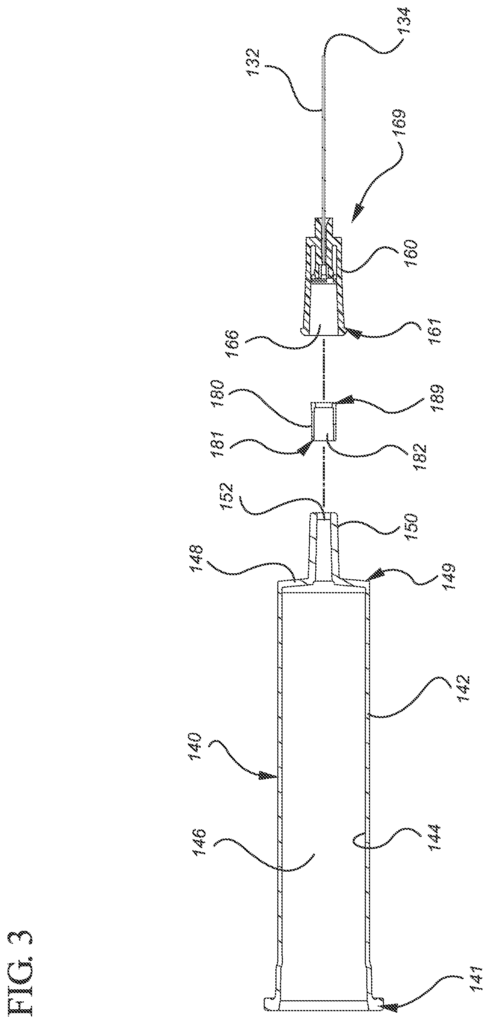
FIGS. “FIGS. 1-7 depict an embodiment of a medical device assembly with an optional needle cannula attached to a hub. FIG. FIGS. 1-7 show an alternative fluid storage container in the form of the syringe, which can be attached to the hub and form a fluid-delivery system 100. In some embodiments, fluid storage container has a sidewall with an inner surface 144 defining a chamber 146 to hold the contents, which can include medication. The container 140 has an open proximal 141 end and a closed distal end and distal wall. The distal wall includes a luer 150 with an opening 152 that is in fluid communication to the chamber 146. The fluid container 140 can include a plunger 120 that is inserted in the proximal portion 141. The configuration shown in the figure is only exemplary and components may be of different size and shape than those shown.
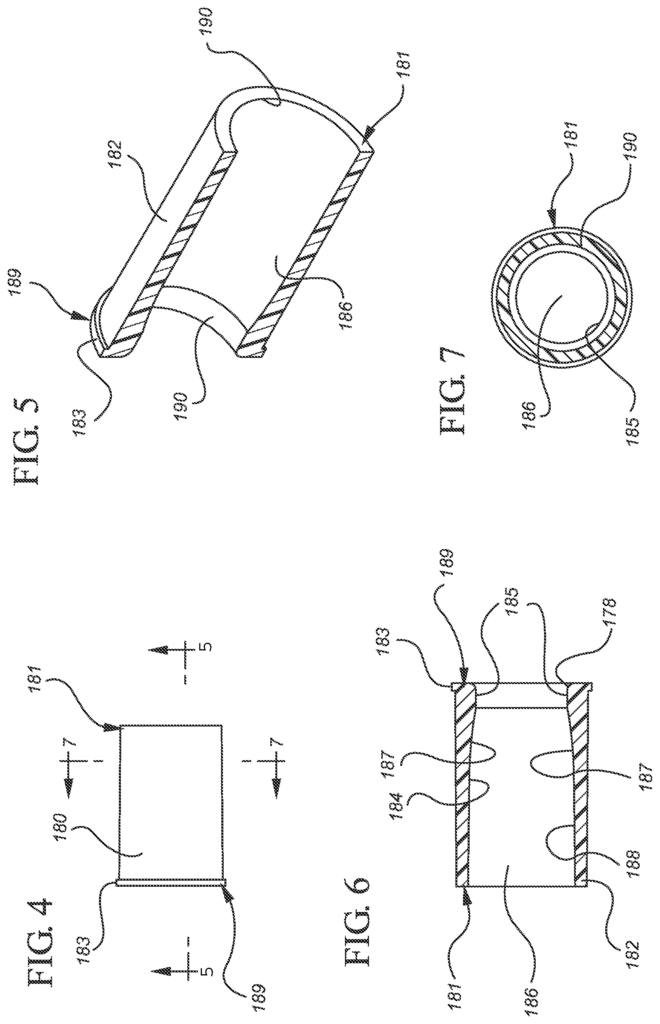
Click here to view the patent on Google Patents.
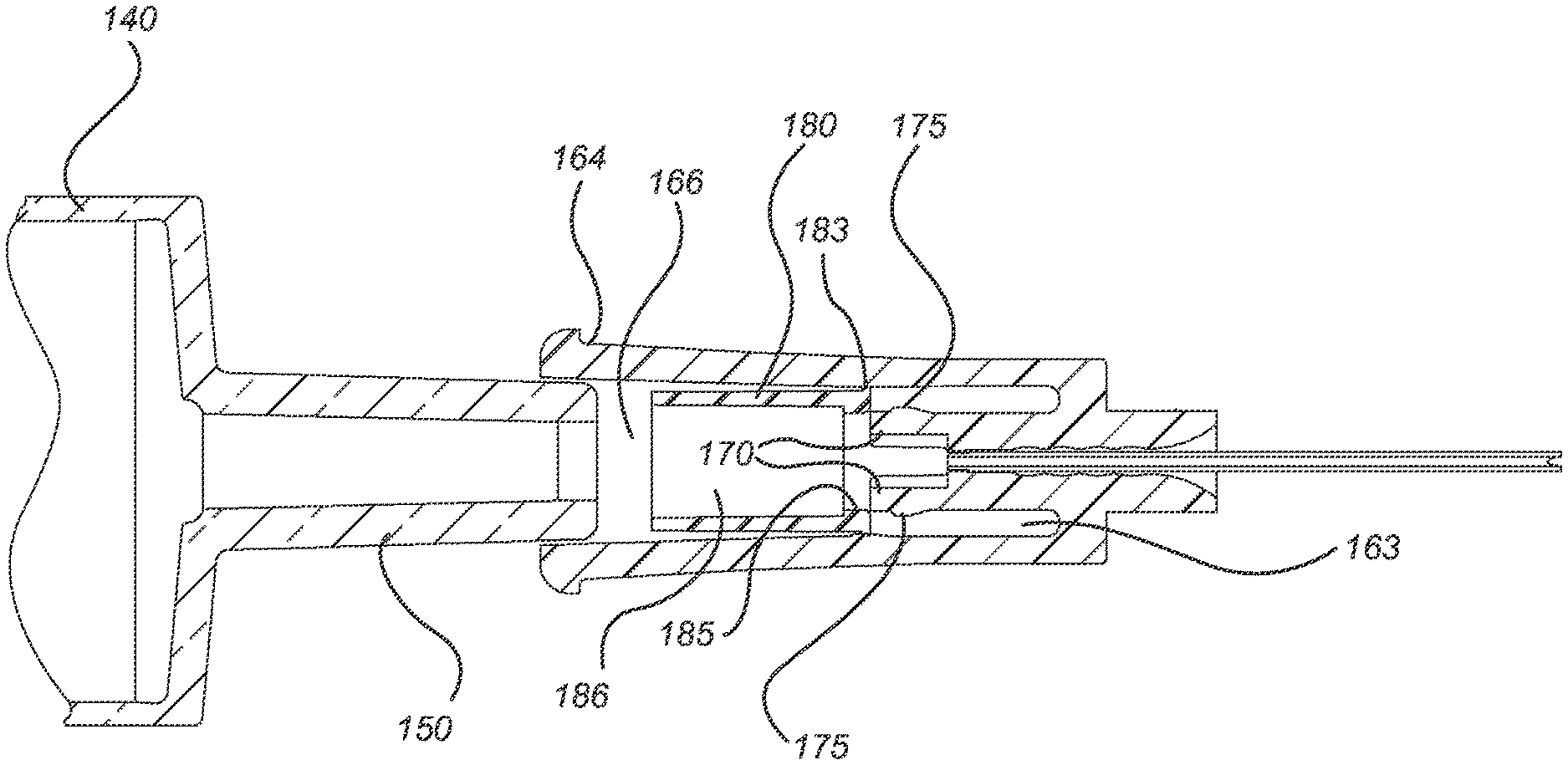
Leave a Reply